详解ILProtector并写出脱壳机
ILProtector的核心保护原理是动态方法。本文详细介绍了ILProtector的保护细节,并针对性地写出脱壳机。
前言
ILProtector应该算是一款强度不是太高,兼容性还不错的壳,网上有关这个壳的资料几乎没有。但是有CodeCracker大神放出的脱壳机和一些基于他的脱壳机改进得到的脱壳机。
这些脱壳在最新版本的ILProtector上已经失效了,但是原理并没有失效。许多人只是使用这些脱壳机,是并不知道其中的原理。这些脱壳机一失效,便无法脱壳。
本文将详解ILProtector的加壳原理并基于GitHub上开源的一个项目(ILProtectorUnpacker by RexProg)写出属于自己的脱壳机。
在研究之前,我们还是需要找到一个ILProtector加壳的样本。很遗憾,没在网上找到最新ILProtector加壳的UnpackMe,所以我们直接拿ILProtector主程序开刀(官网上写了”ILProtector is protected by itself!”)。
在研究的时候,用的是2.0.22.4版本的ILProtector,但是写文章的时候发现ILProtector更新到了2.0.22.5,有点尴尬。但是我测试过了,2.0.22.5和2.0.22.4并没有区别,所以本文还是以ILProtector v2.0.22.4主程序为样本来研究。这里提供打包好的文件下载:ILProtector v2.0.22.4.7z
ILProtector保护方式概览
我们先用dnSpy打开ILProtector看看这究竟是怎样保护的:
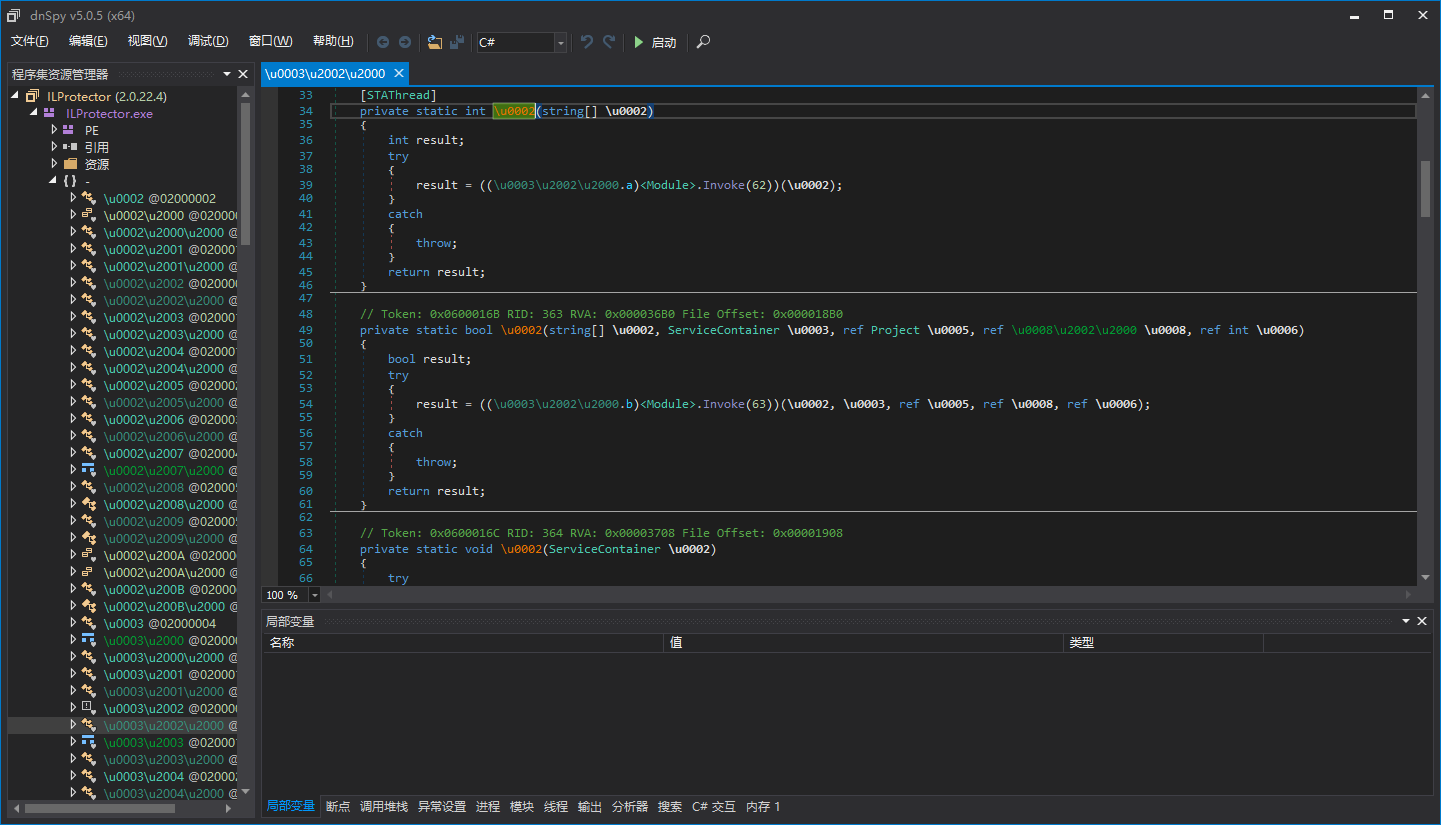
我们可以看到方法体被隐藏了,全部被替换成了”<Module>.Invoke(num)”。尝试用dnSpy调试:
先在Main方法这里下断点:
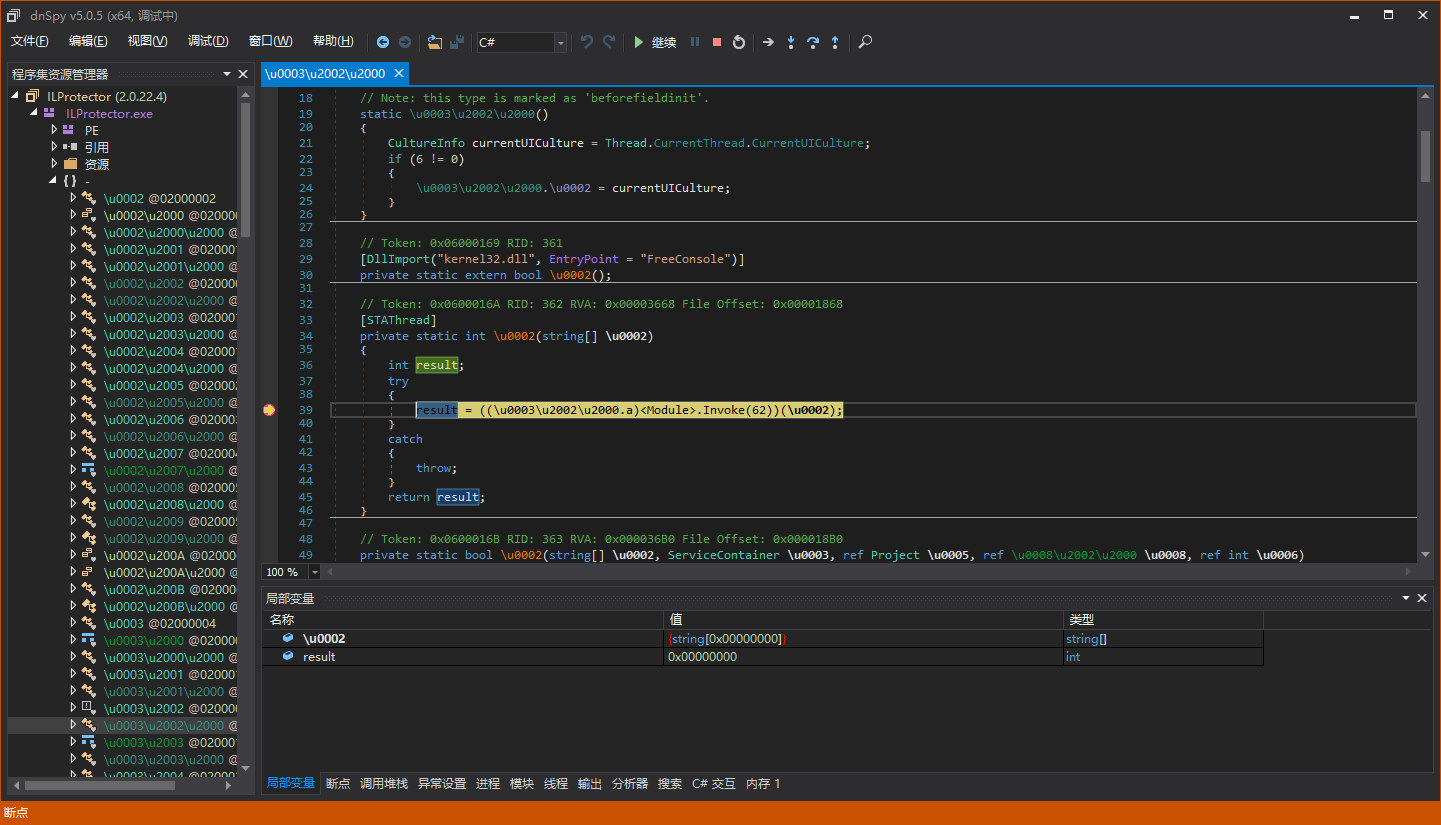
断下来后按F11单步:
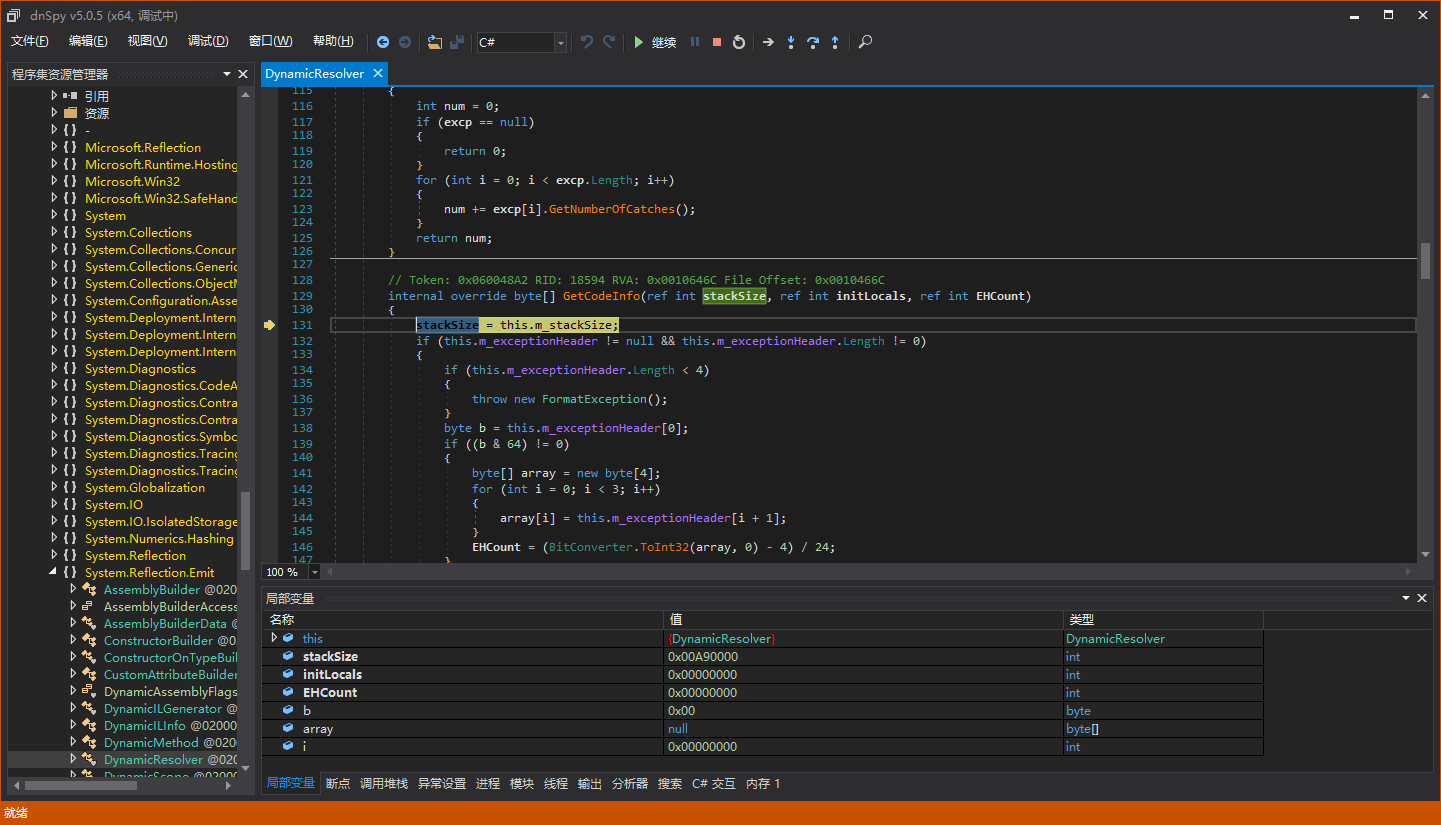
可以初步判断出应该是用了DynamicMethod,我们在DynamicMethod的构造器处下断点,并按F5运行:
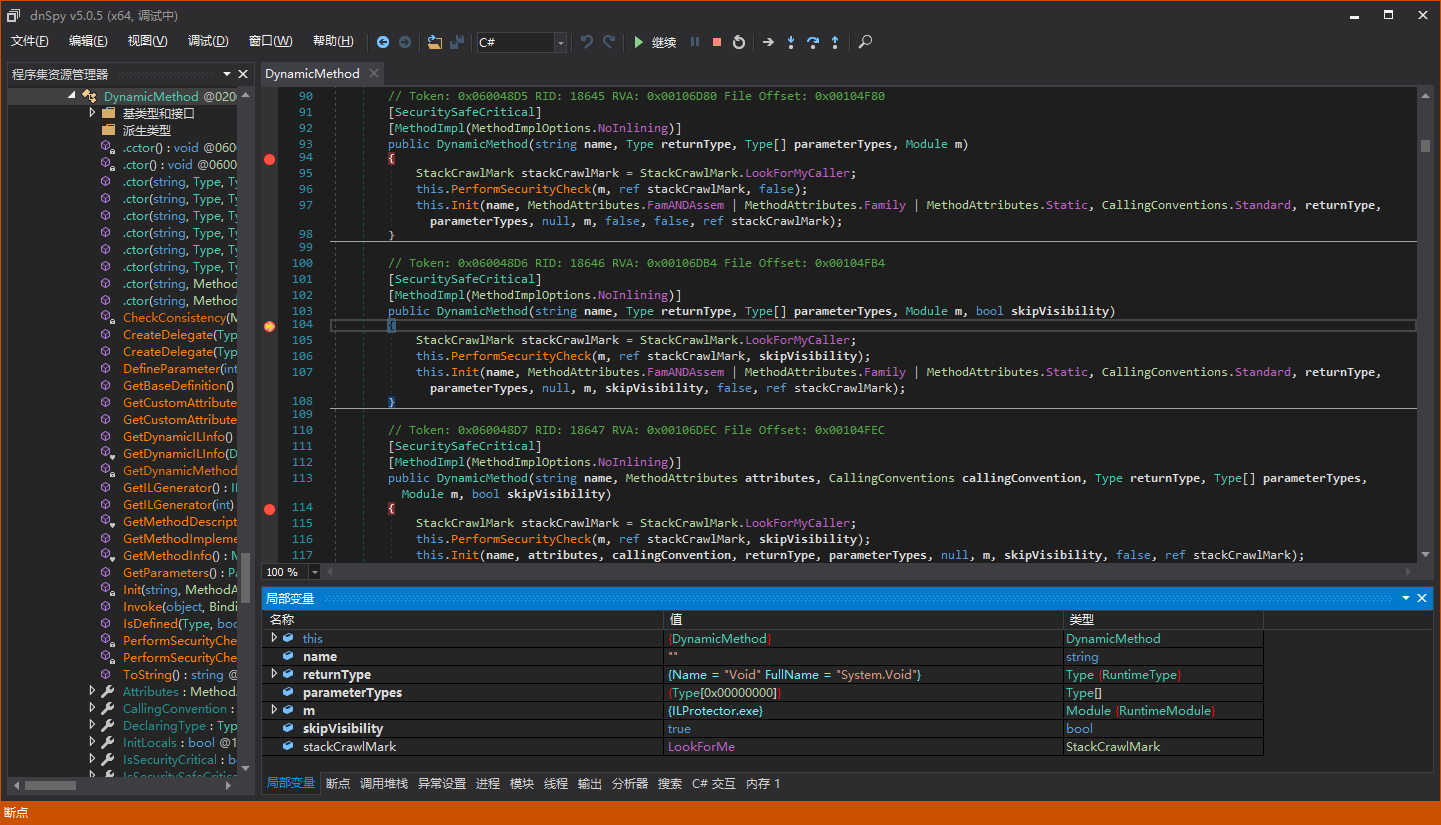
没错,我们的猜错是对的,ILProtector用了DynamicMethod动态生成一个方法体来保护程序集的。
RexProg的ILProtectorUnpacker的脱壳原理
脱壳流程
为了避免各种没有特别大意义的尝试,我们来看看文章开头提到的那个开源项目是怎么实现脱壳的。我们先在vs里面打开这个项目。(这个提供打包好的项目下载:ILProtectorUnpacker by RexProg.7z)
找到Main方法,看看是怎么一回事(下面的注释都是我自己加的):
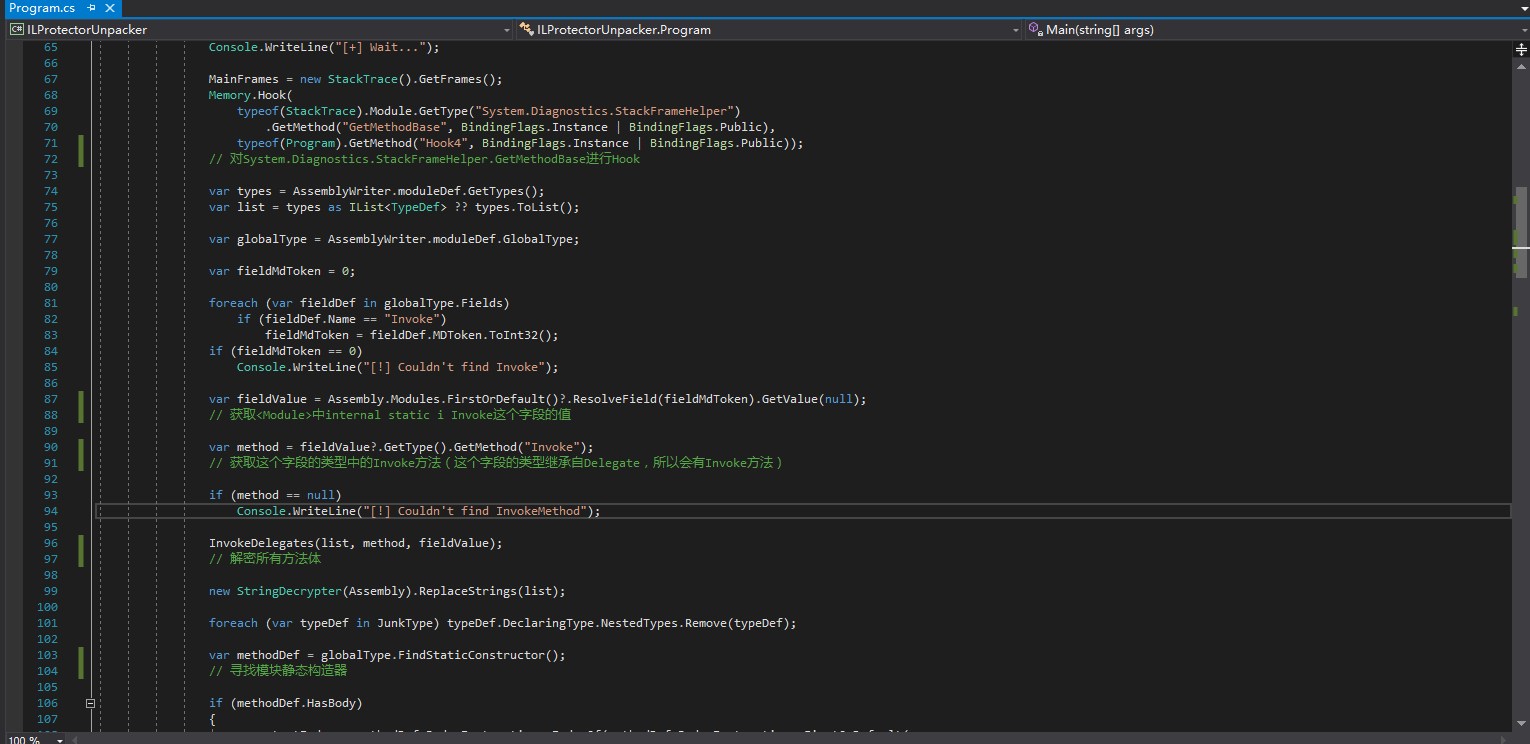
可以发现真正的实现是在InvokeDelegates中,转到这个方法:
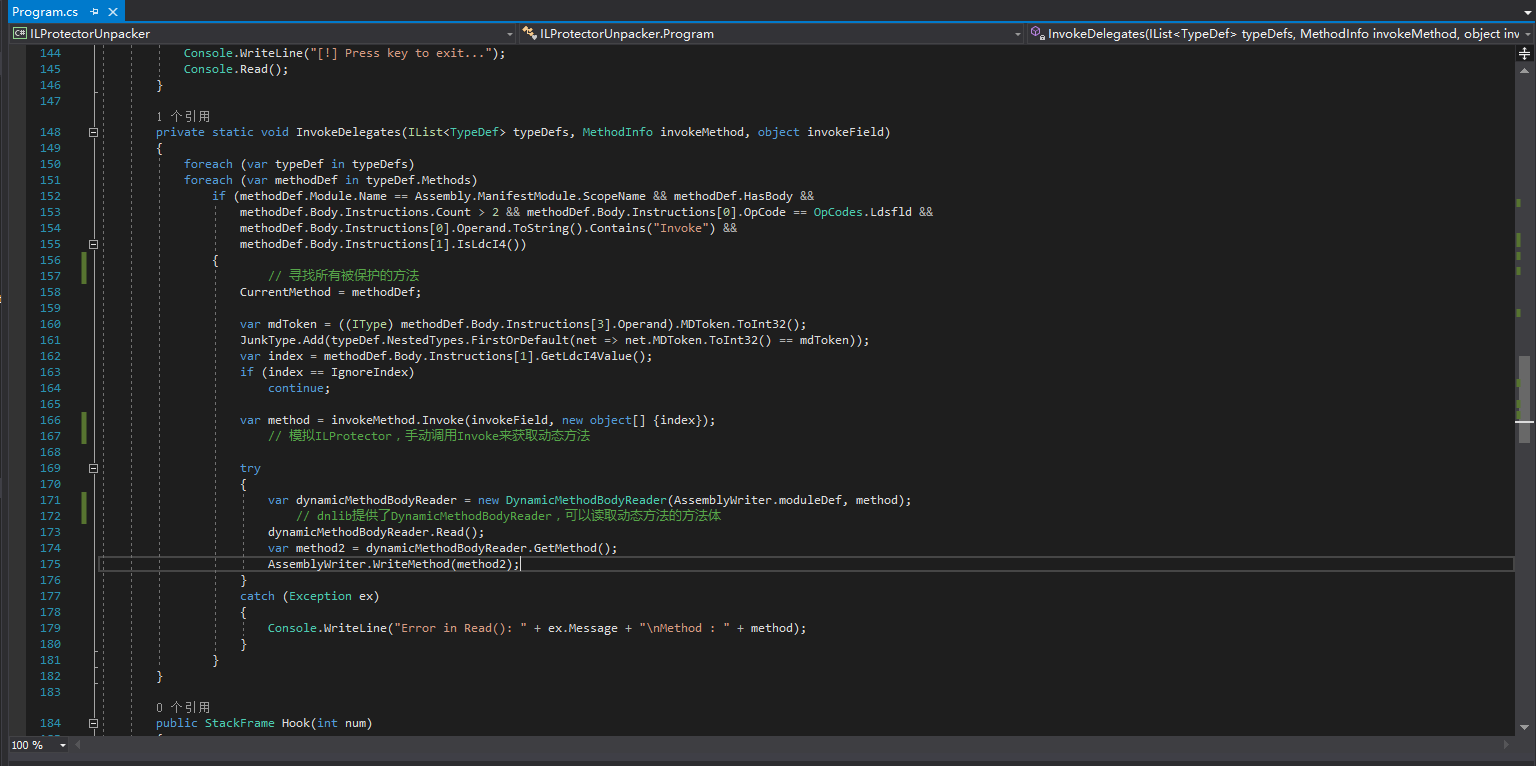
过检测
此刻我们大概搞懂脱壳机的脱壳流程了。脱壳机先加载被保护的程序集,接着对一个地方进行Hook,然后手动调用Invoke来获取动态方法,再使用dnlib提供的DynamicMethodBodyReader读取这个动态方法的方法体,还原到文件中的方法体中。刚才提到了Hook,既然是Hook,那八九不离十的与过检测有关,我们来看看Hook了什么玩意:
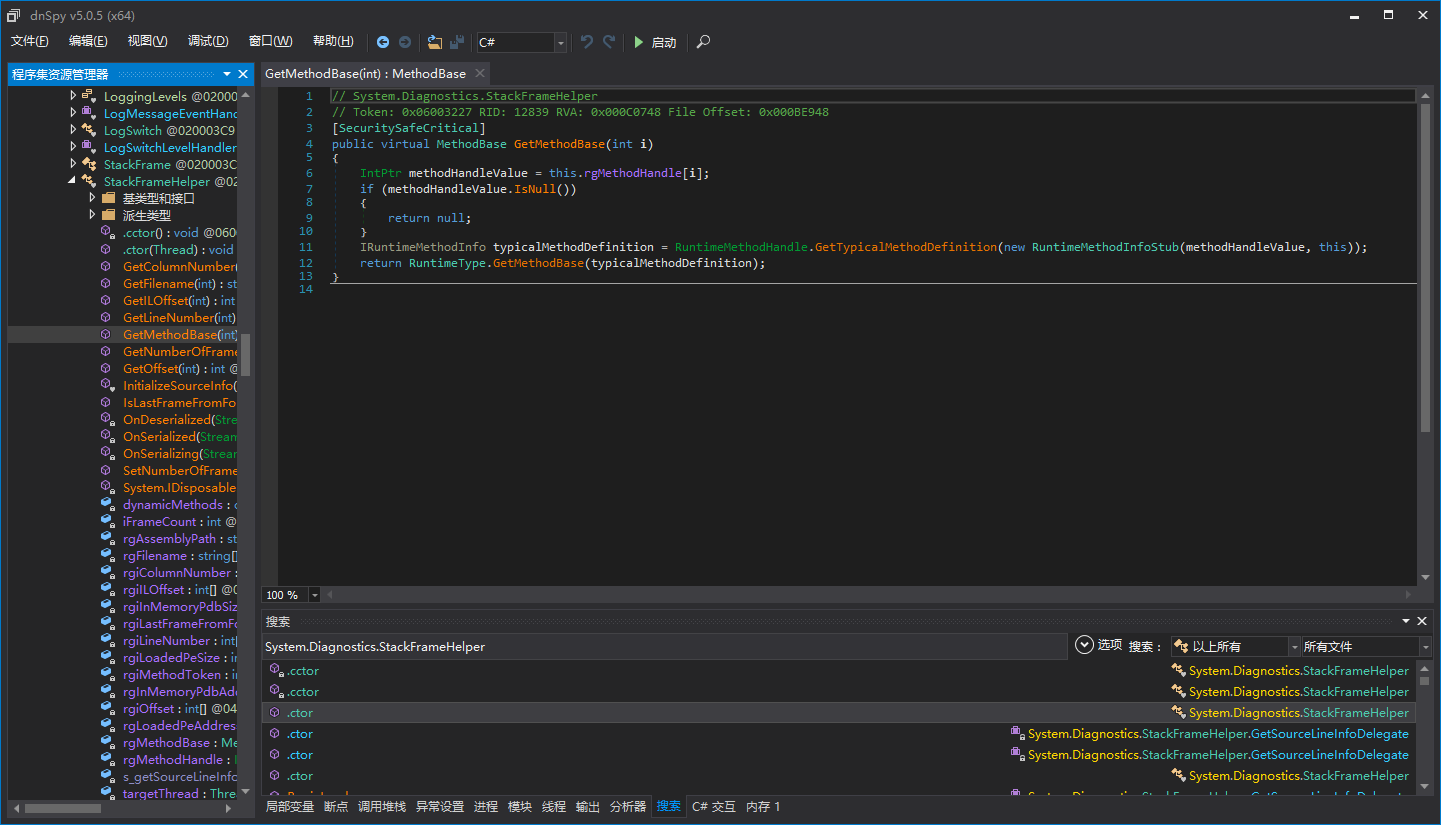
对应的Detour:
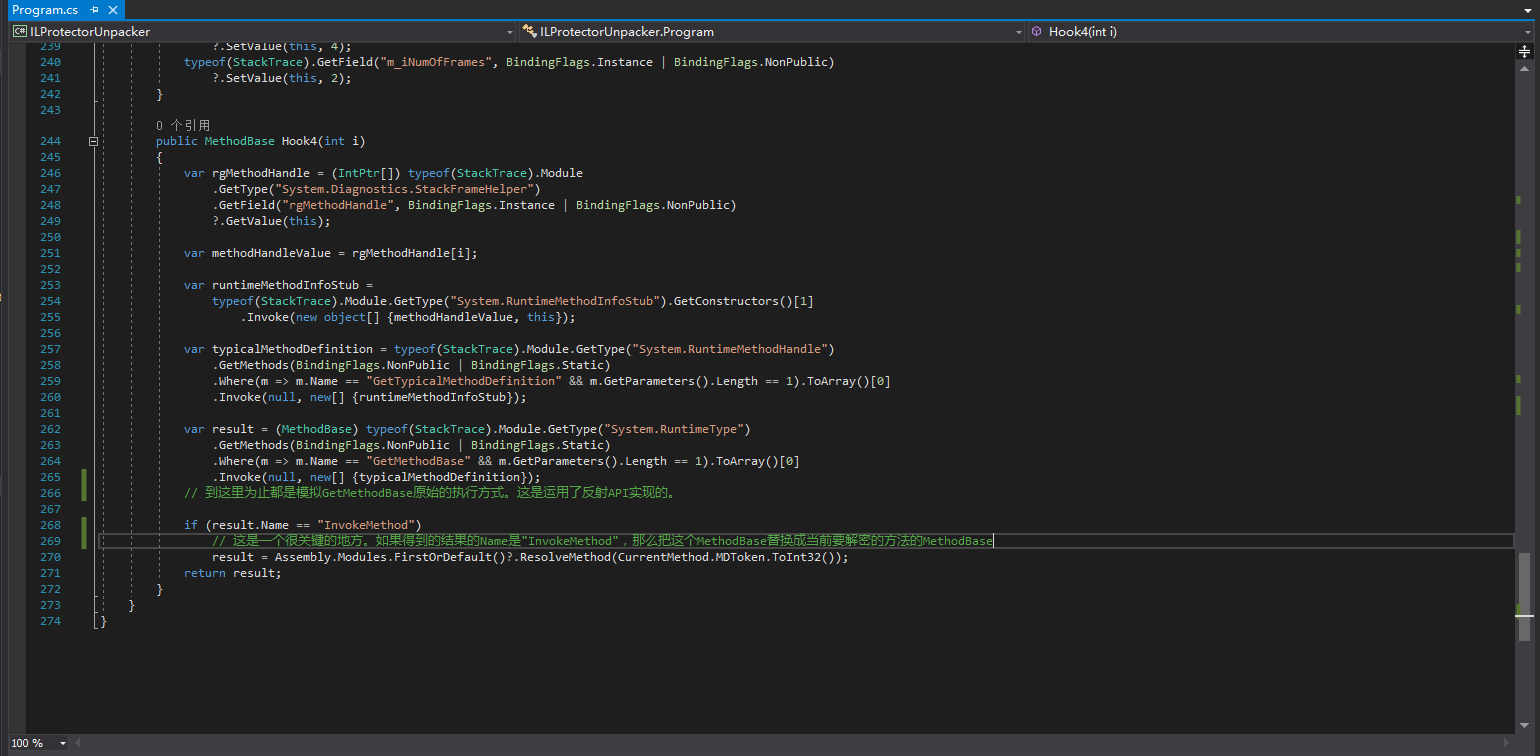
到这里我们不是特别明白为什么要Hook System.Diagnostics.StackFrameHelper.GetMethodBase,也不明白”if (result.Name == “InvokeMethod”)”中的InvokeMethod是何方神圣,我们再次用dnSpy搜索并反编译InvokeMethod看看:
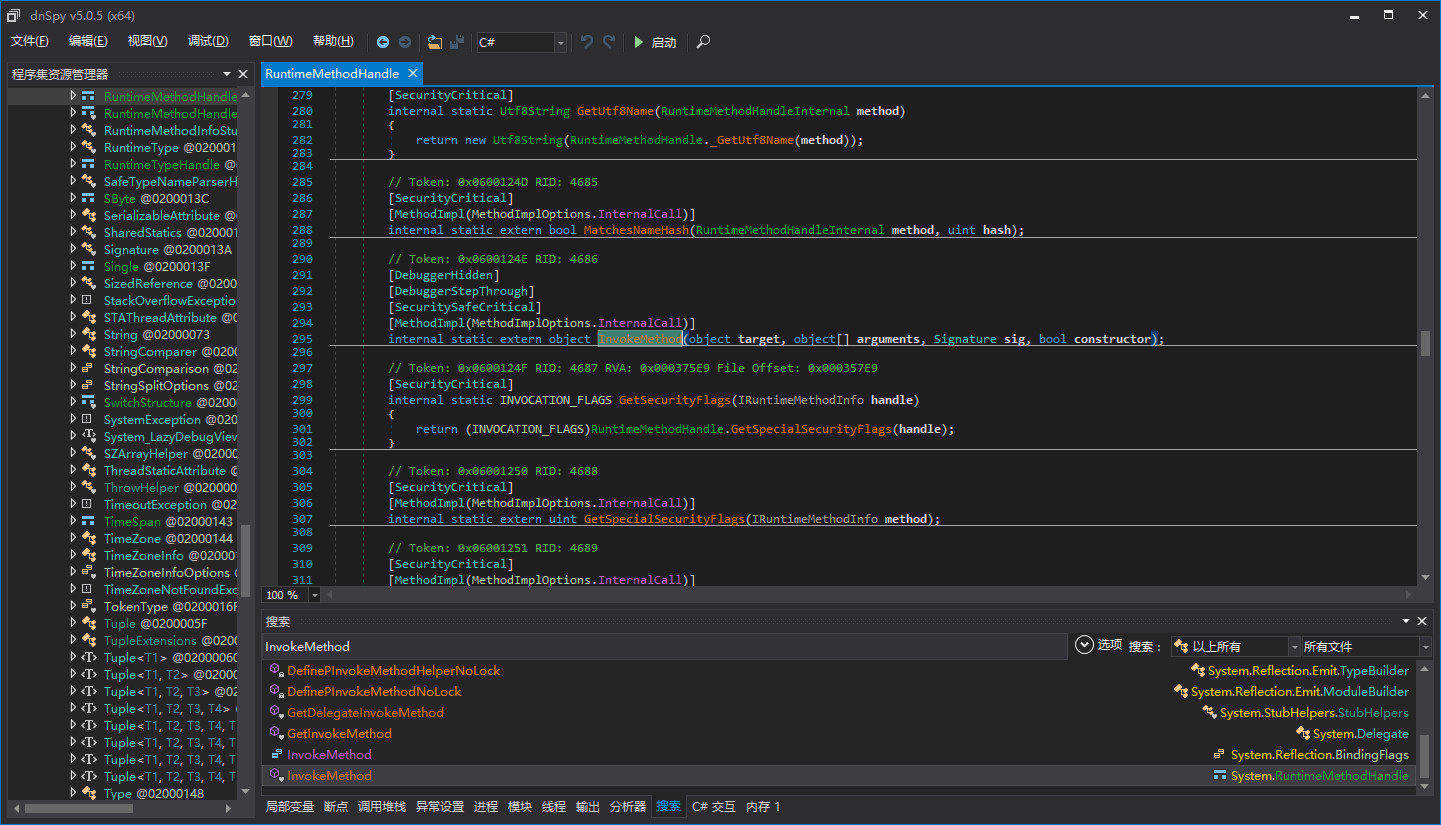
如果有点逆向经验的,应该会知道这个是调用MethodInfo.Invoke时,在托管代码中进入CLR的地方,可以理解成Win32编程中R3转到R0的地方。
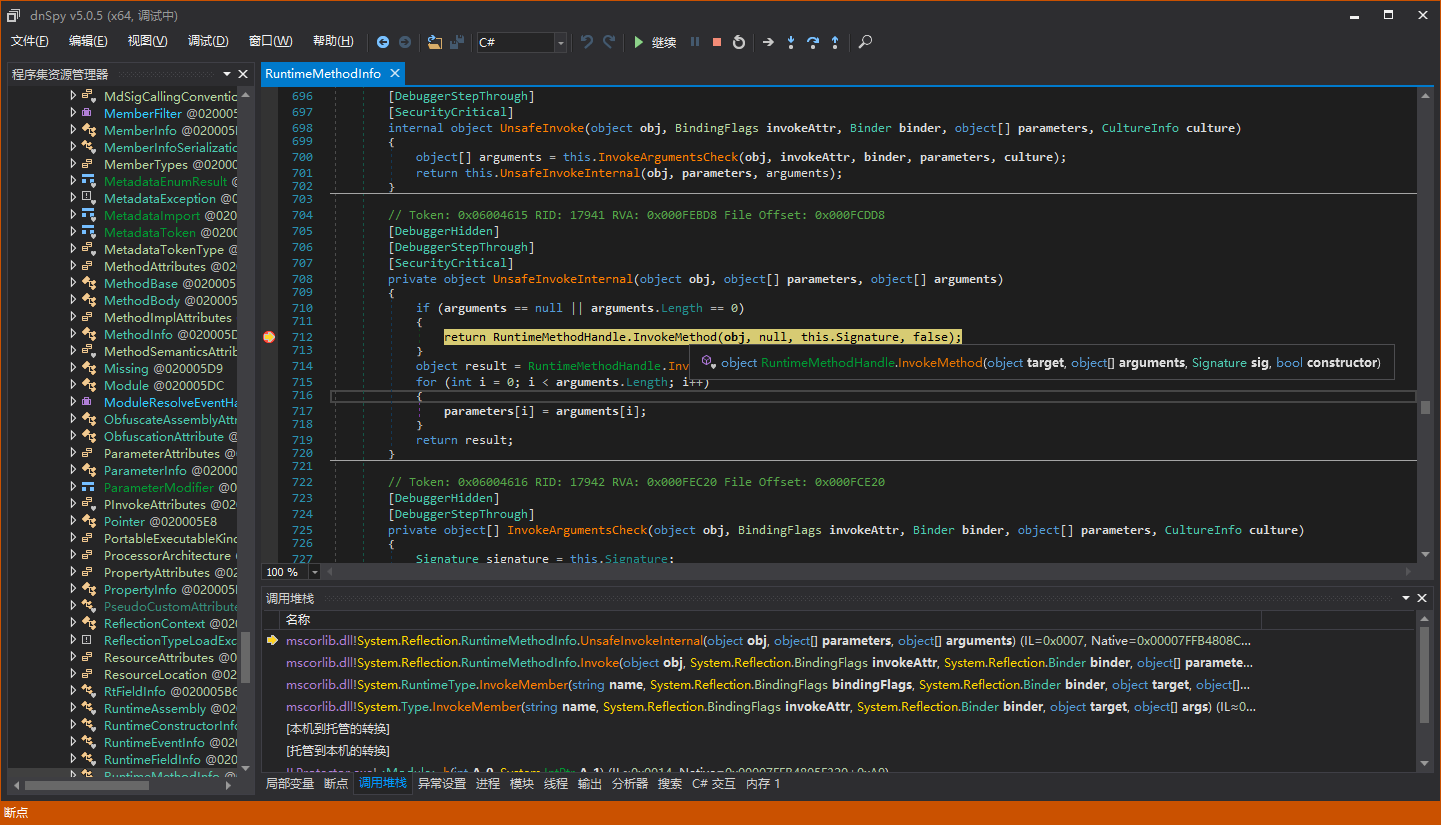
再结合一些反非法调用的检测原理,可以知道,ILProtector会检测调用堆栈中,被保护方法的上一个方法,比如这样:
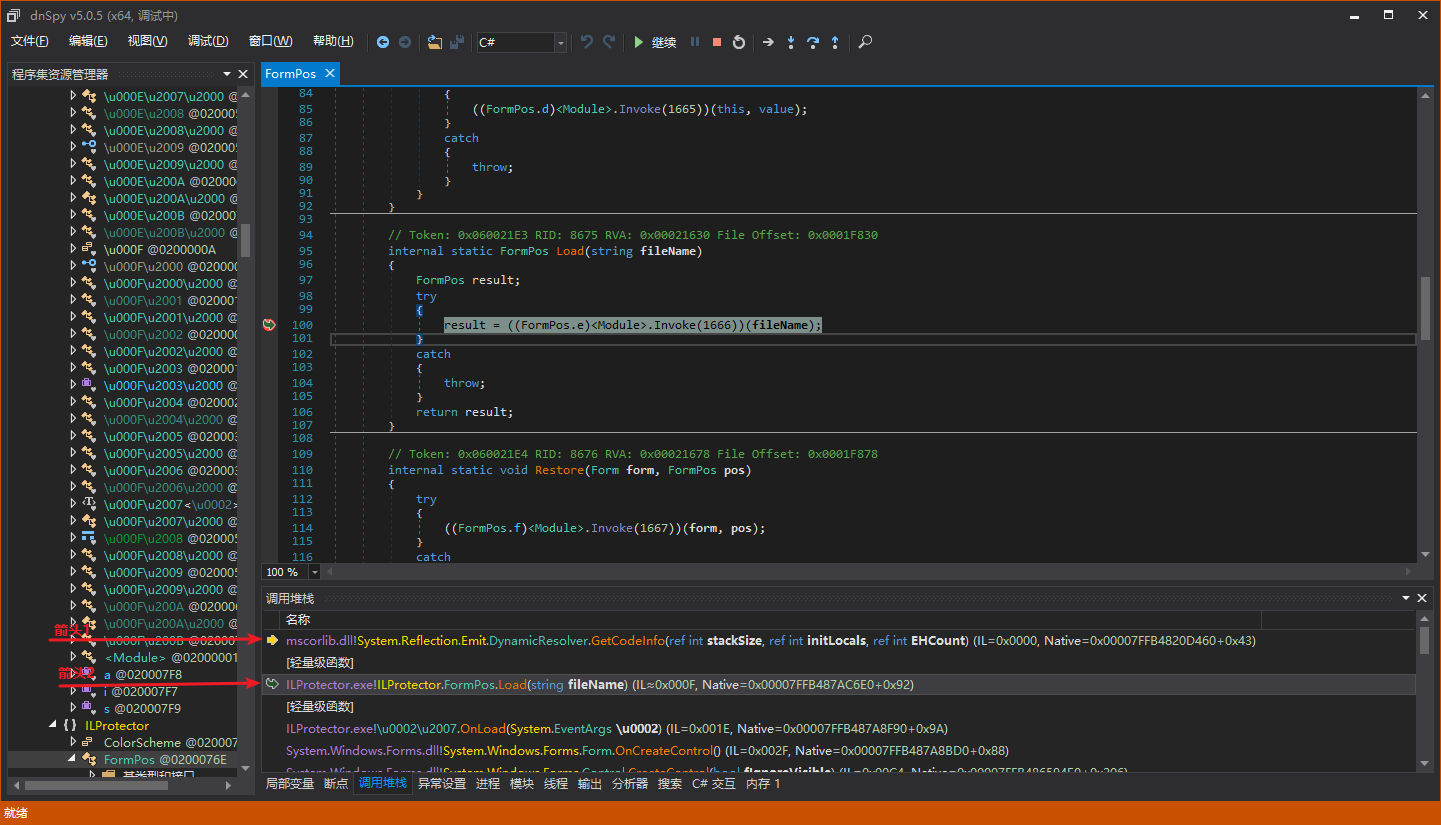
假设箭头2指向的是被保护的方法,箭头1指向的是与ILProtector运行时的非托管代码(当成是,因为dnSpy没法单步进入非托管代码),那么运行时的非托管代码会检测箭头2指向的调用者(Caller)是不是被保护的方法,即这里的”internal static FormPos Load(string fileName)”。如果我们手动Invoke来获取动态方法,那么非托管代码检测到的就不会是”internal static FormPos Load(string fileName)”了,而是刚才提到的”System.RuntimeMethodHandle.InvokeMethod”,所以RegProg的脱壳机Hook了GetMethodBase,并且写了
1 | if (result.Name == "InvokeMethod") |
来过检测。
这段解释有点难理解,虽然尽可能的详细解释了。读者可能会看不太明白,但是知道个大概,所以还是需要自己调试跟踪看看,实践才能真正学习到知识!
出错了!
看着我写的,是不是觉得ILProtectorUnpacker写得非常完美?但是道高一尺魔高一丈,有了过检测,也会有反过检测。我们直接编译RexProg的脱壳机并运行:
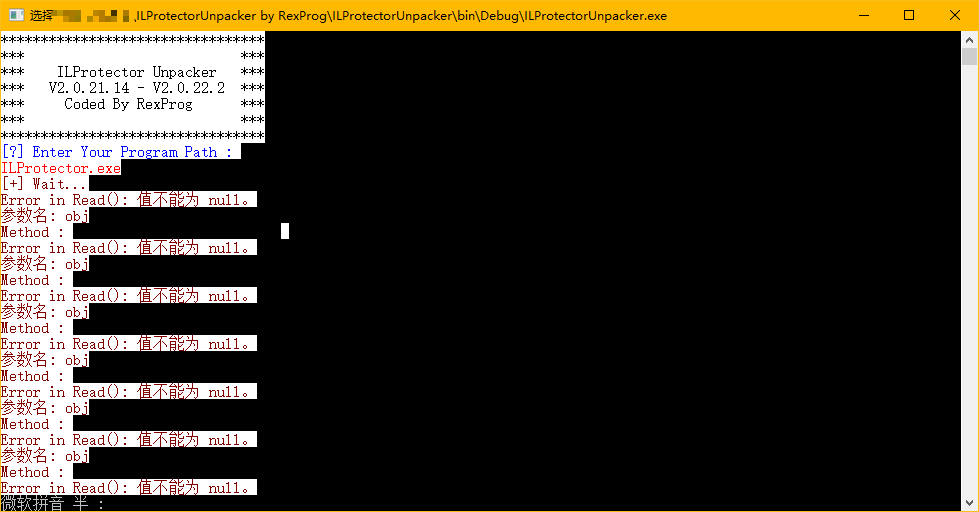
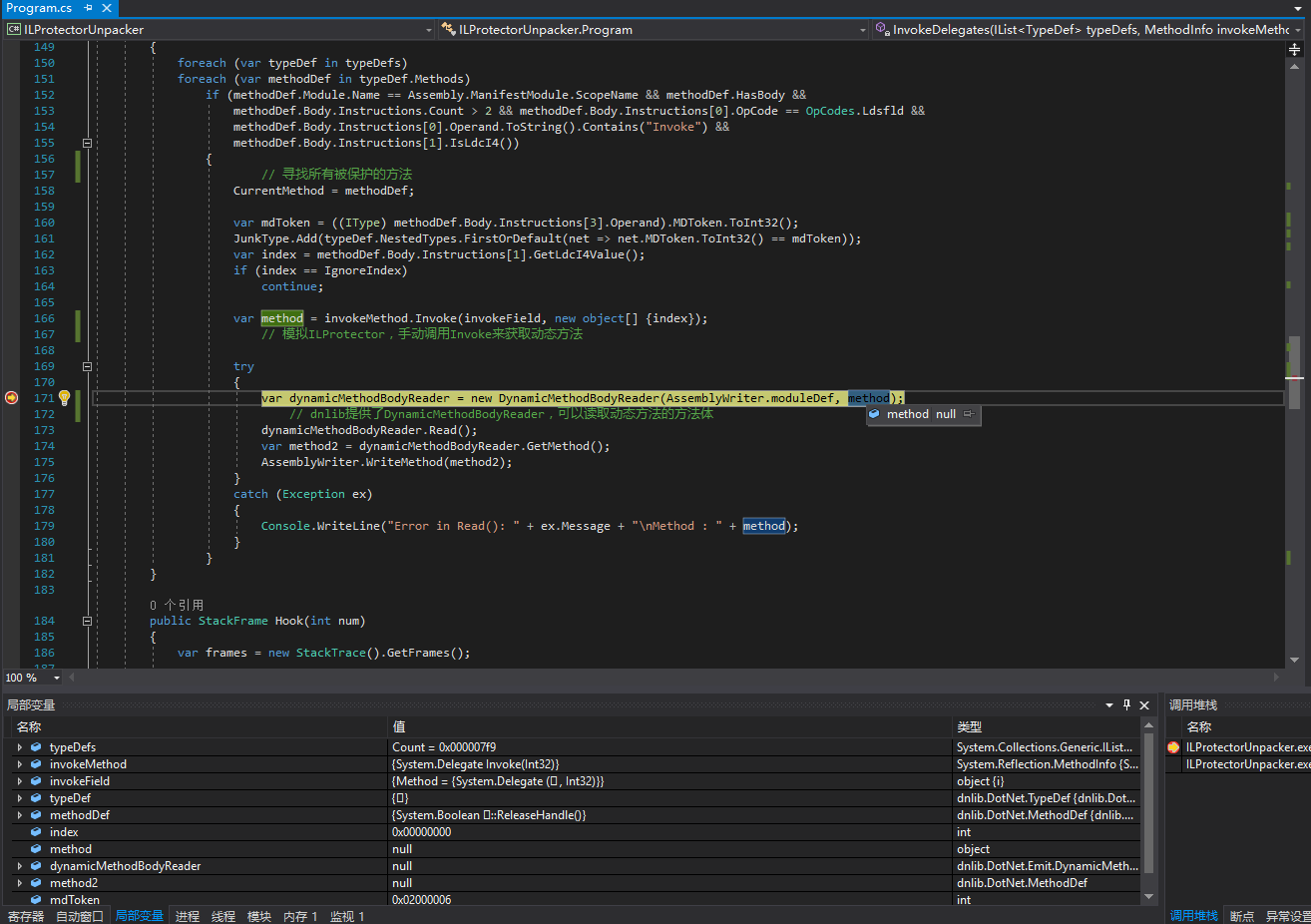
为什么会这样呢,经过各种分析和尝试,也为了文章更简洁,这里将直接写上正确的分析反过检测过程(ILProtector检测到了我们手动调用Invoke)
ILProtector的检测
首先,ILProtector会检测调用堆栈,我们进行处理了,并且正常工作,那么为什么还会被ILProtector检测到非法调用呢?答:ILProtector检测到了我们的Hook。
先修改一下Memory.Hook,让它输出一些信息(Hook中Target的地址和Detour的地址):
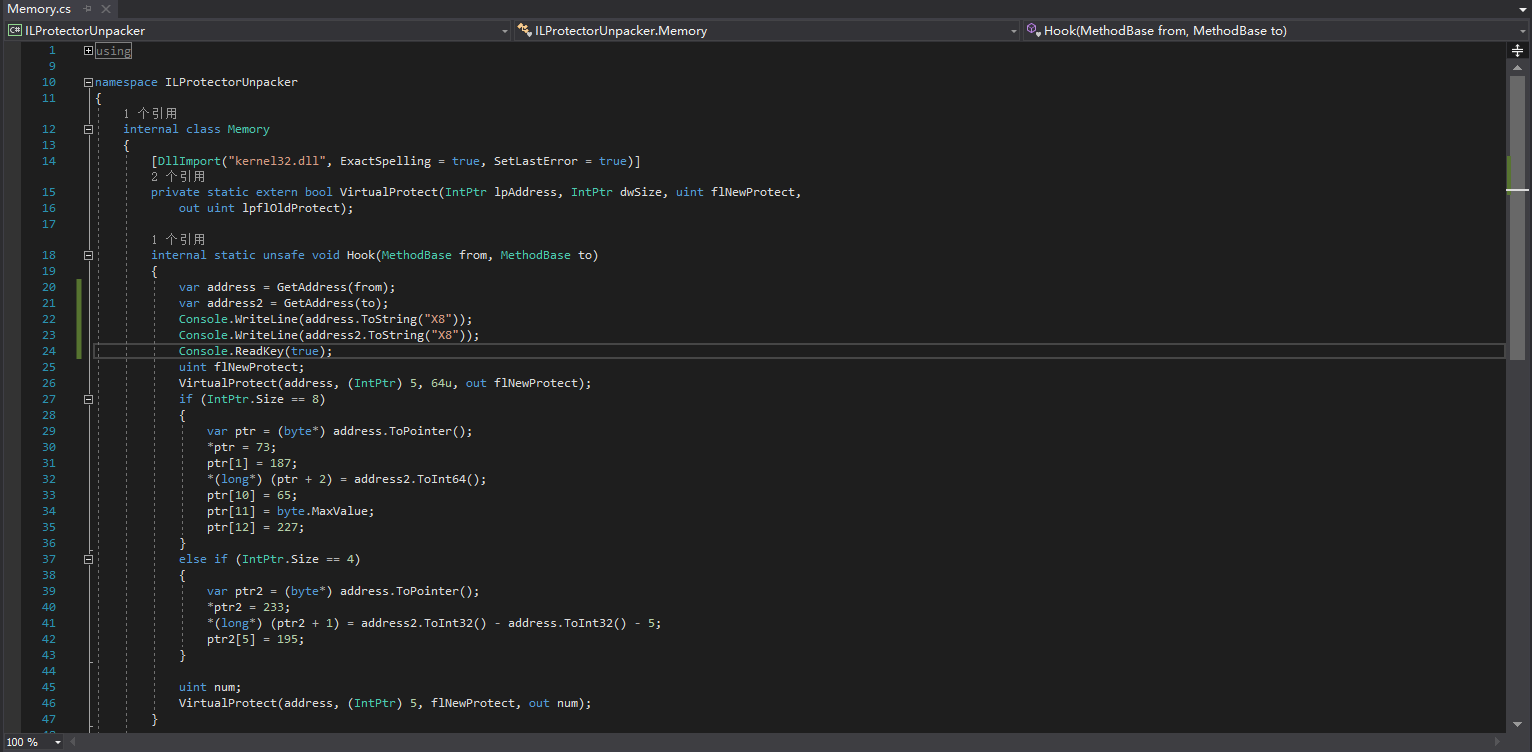
打开x64dbg,启动脱壳机,并让脱壳机运行,到”Console.ReadKey(true);”处停下就行:
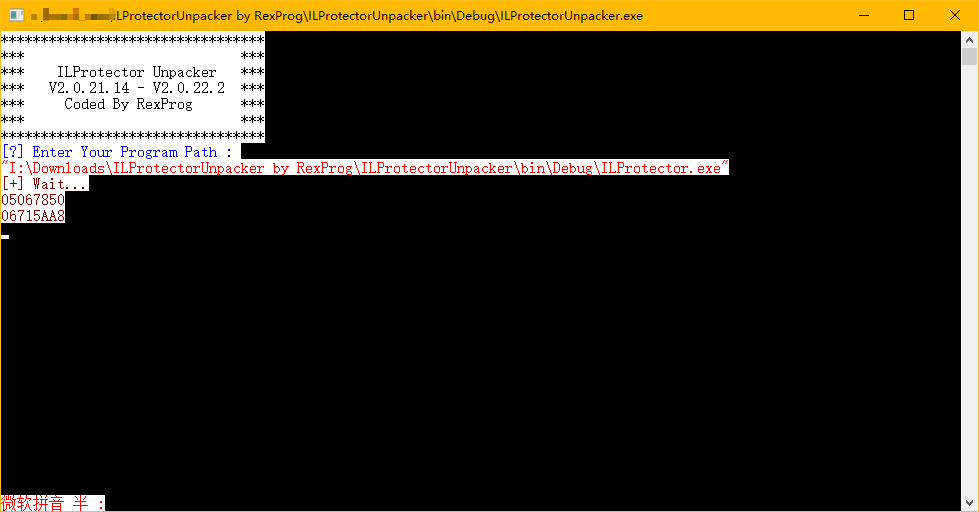
到x64dbg的内存窗口中转到第一个地址,第一个地址是被Hook的方法的地址,即System.Diagnostics.StackFrameHelper.GetMethodBase的地址,然后给System.Diagnostics.StackFrameHelper.GetMethodBase下硬件访问断点:
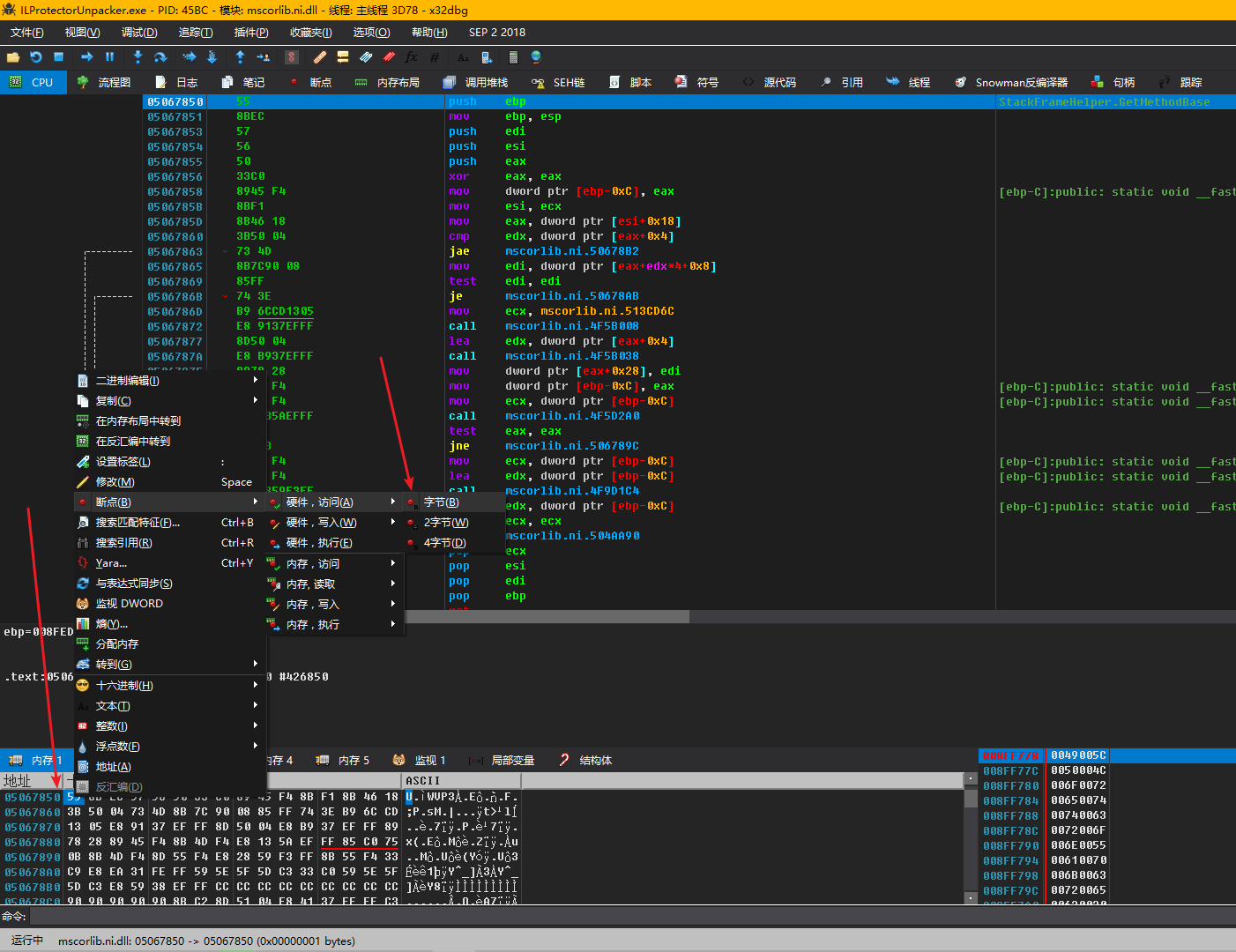
控制台里面随便按一个按键,让脱壳机继续执行,直到断在了ProtectXXX.dll。
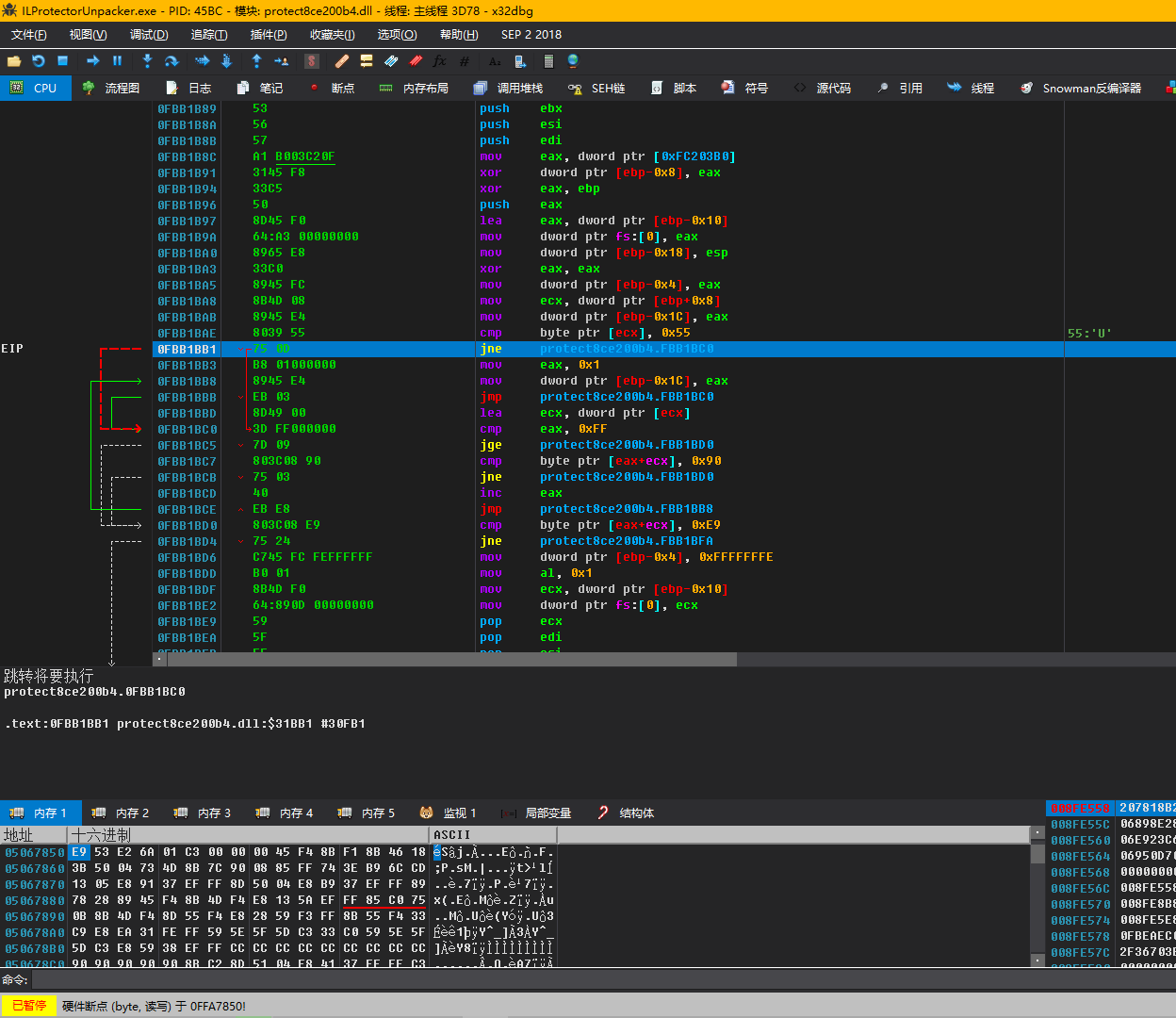
这里是一个jcc指令,更能证明这里是检测是否被Hook。为了方便,而且这是个未加壳的DLL,我们直接上IDA,反编译这个Hook检测函数。这个函数的RVA是0x31B70,所以直接在IDA中搜索”31B70”。
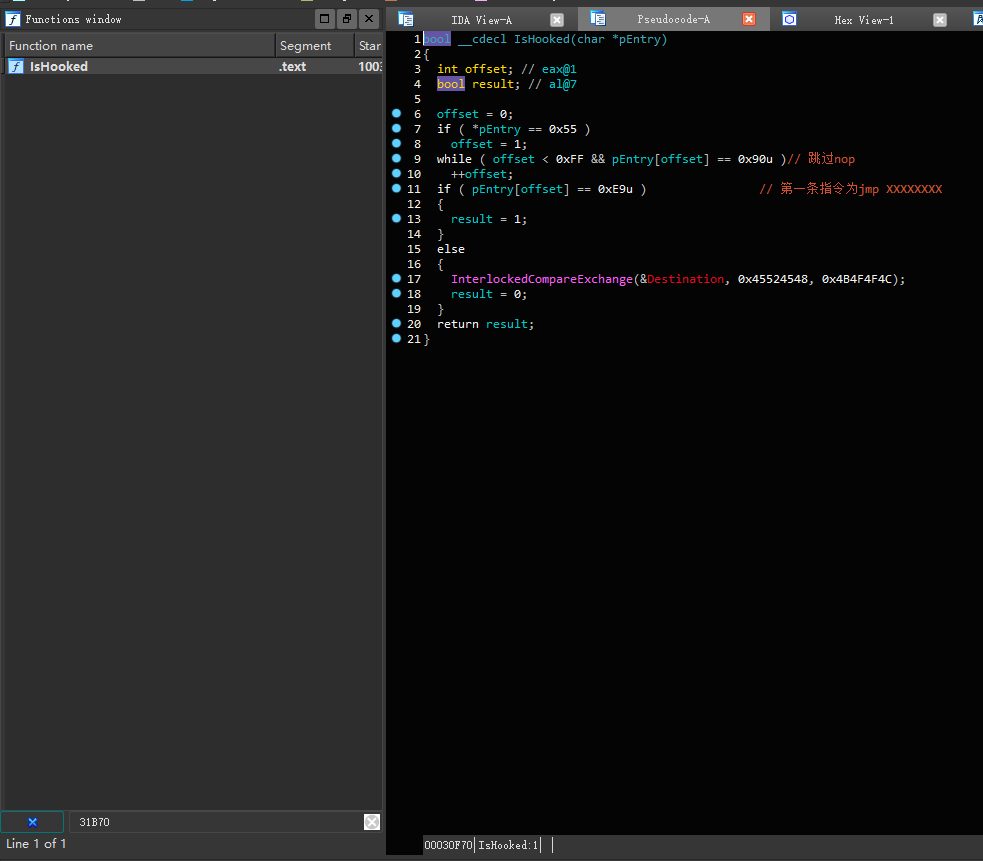
我已经把代码重命名好了,所以读者可以直接思考这段检测的原理。我还是大概解释一下这个检测:
IsHooked(char *pEntry)会被传入要检测的地址,比如这次用x64dbg调试,被传入的地址就是0x05067850。
1 | if ( *pEntry == 0x55 ) |
这段代码可以认为是垃圾代码,不需要理解
1 | while ( offset < 0xFF && pEntry[offset] == 0x90u )// 跳过nop |
跳过nop
1 | if ( pEntry[offset] == 0xE9u ) // 第一条指令为jmp XXXXXXXX |
判断nop后(如果存在nop)的第一条指令是不是jmp。如果是jmp,返回true,表示检测到了Hook;如果不是jmp,表示代码正常,未被Hook,设置一个标志后(这个标志不用管),返回false。
再过ILProtector检测
可是别忘了我们有无数方式来写点JunkCode,直接就过掉了检测。
我们先看看脱壳机把System.Diagnostics.StackFrameHelper.GetMethodBase改成什么样了:

难怪会被检测到,这第一条指令就是jmp,Hook得太直接了。我们玩点花样,在”jmp 0x06715AA8”前面加个0xEB 0x00,相当于”jmp eip/rip+2”。

按F8单步到Hook检测返回,可以发现,它返回false了。按F5发现脱壳机不报错了,也就是我们的再过检测成功了!
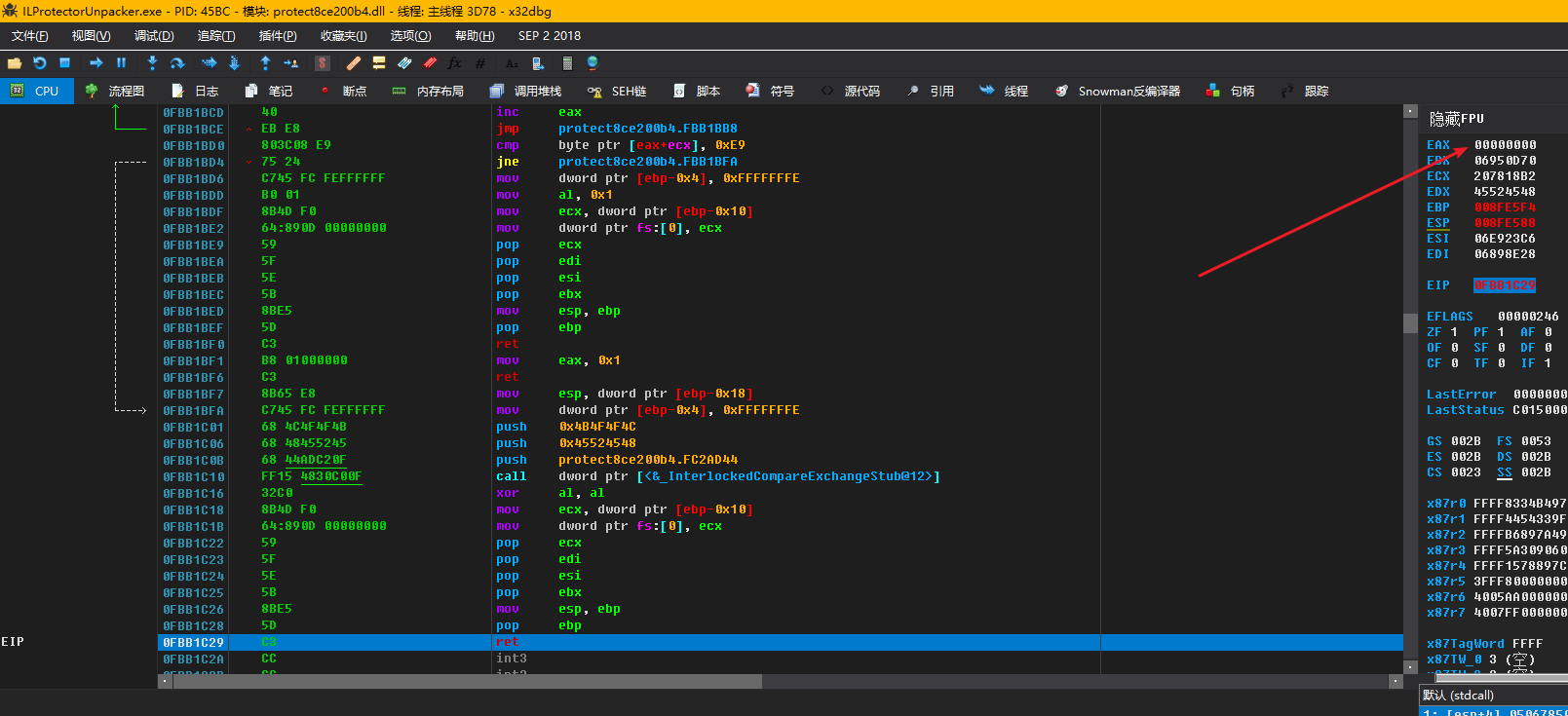
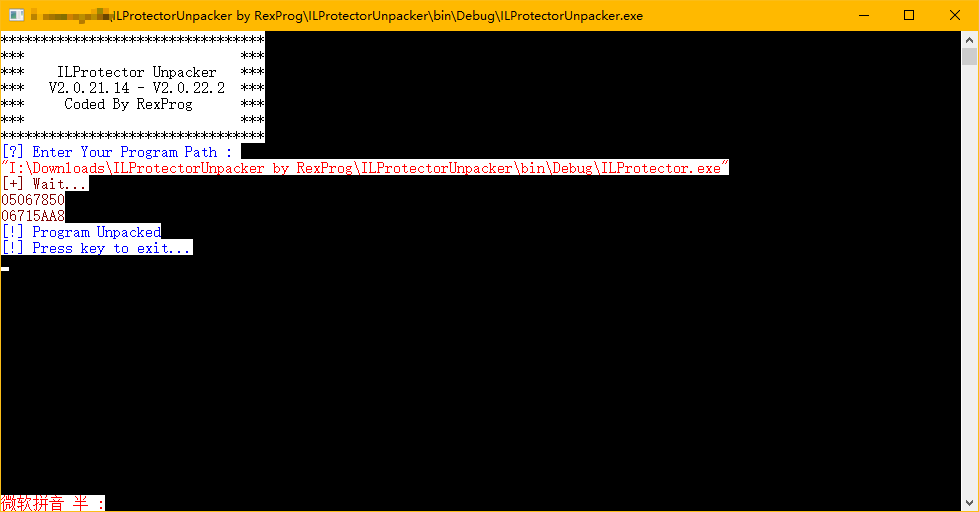
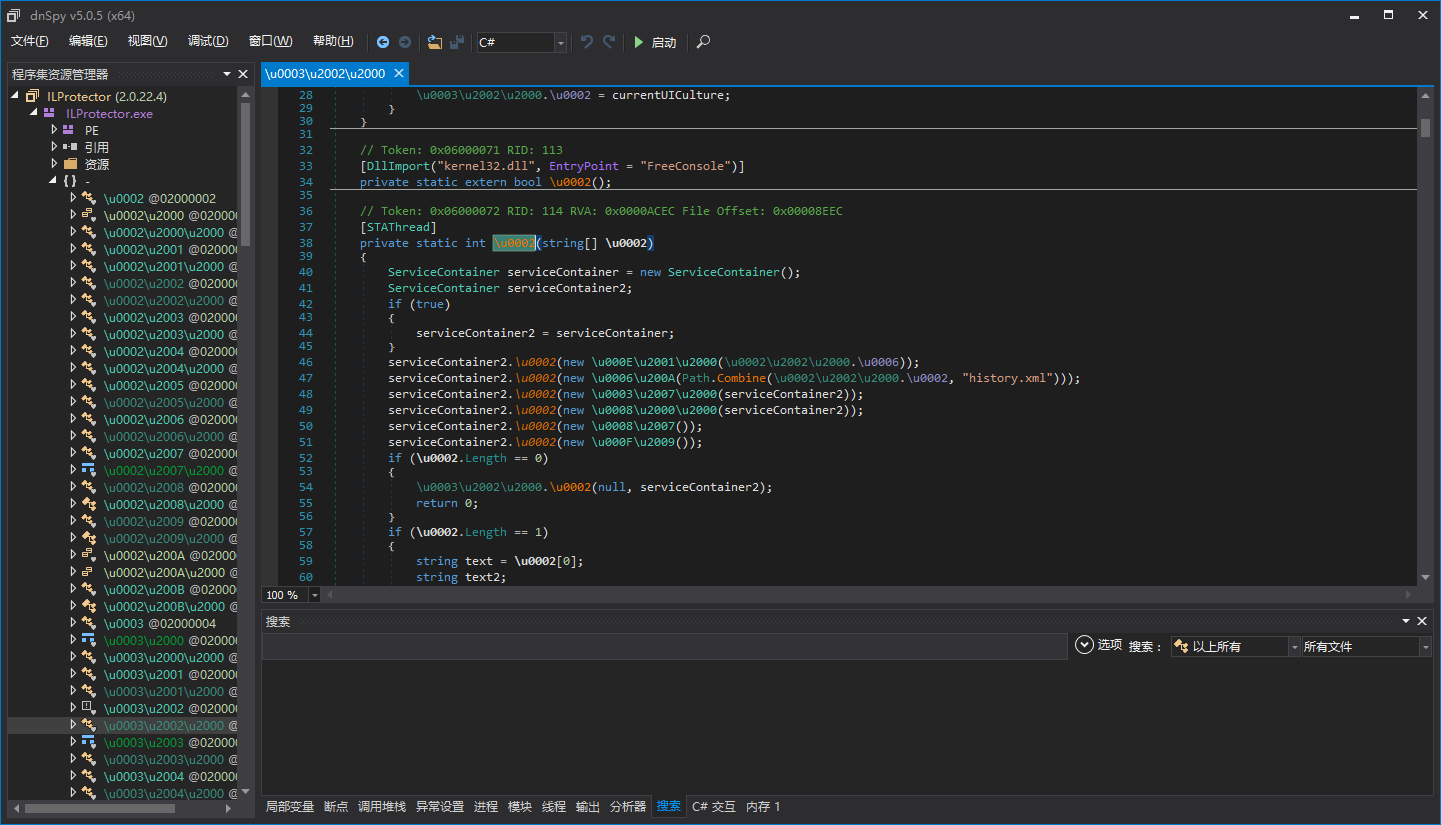
属于自己的脱壳机
那么对RexProg的ILProtectorUnpacker研究和对ILProtector本身的研究可以告一段落了。接下来开始讲解如何自己写一个脱壳机。
写个简单的框架:

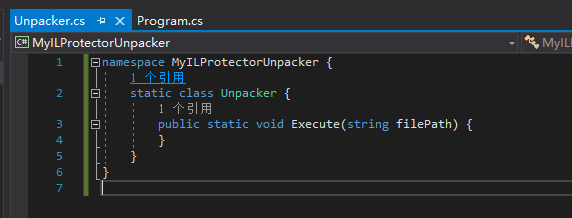
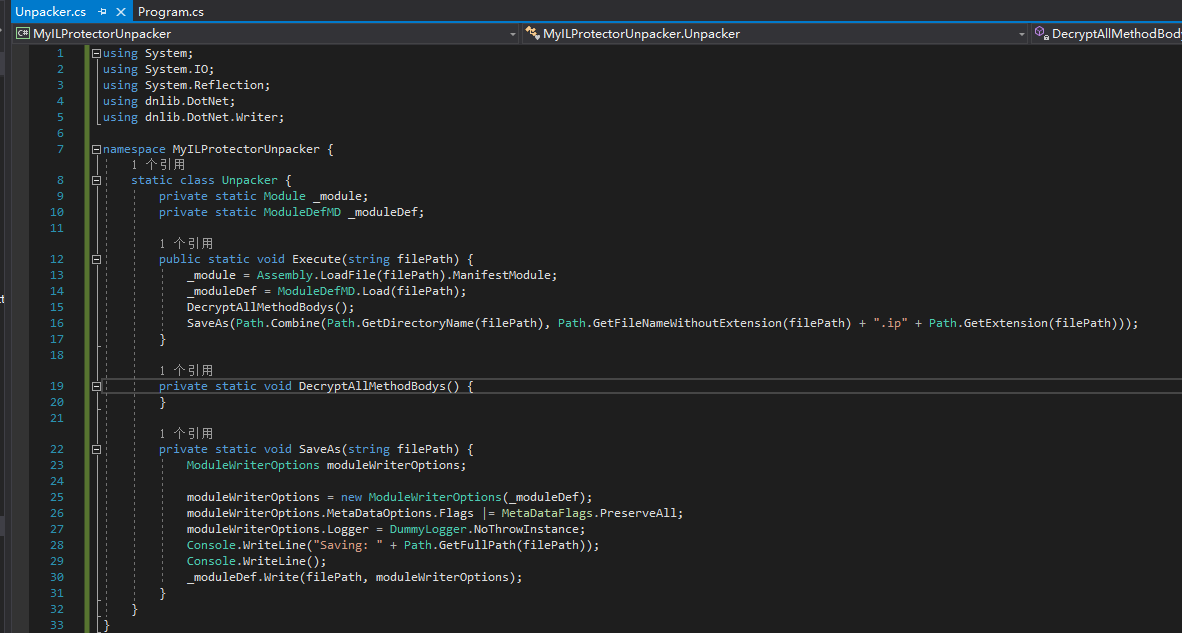
在调用DecryptAllMethodBodys之前,我们得对System.Diagnostics.StackFrameHelper.GetMethodBase进行Hook。
GetMethodBase是实例方法,所以我们专门写一个类来放Detour方法,在这个类的静态构造器里面插入反射API初始化的代码:
1 | Module mscorlib; |
注意,因为是Hook了的,所以this指针是错误的,FieldInfo_rgMethodHandle这样的字段要定义为静态的字段,如果不理解,可以改成非静态,看看如何报错,这里不演示了。
相较于暴力GetMethodByName,我更喜欢用Attribute来获取自己的Detour。我们定义一个DetourAttribute:
1 | private sealed class GetMethodBaseDetourAttribute : Attribute { |
回到那个放Detour的类,写上这样的代码:
1 | [] |
这样我们就可以使用
1 | private static MethodInfo GetMethodByAttribute<TClass, TMethodAttribute>() where TMethodAttribute : Attribute { |
来获取Detour,不用担心什么时候代码被混淆了,GetMethodByName会出错。
1 | private static void* GetMethodAddress(MethodBase methodBase) { |
写上这样的方法,我们再写个新方法,获取Target的地址和Detour的地址,先对Tagret写入JunkCode,再写入真正的Jmp跳转。
此时,我们可以在Execute(string filePath)中加入:
1 | if (Environment.Version.Major == 2) |
接下来,我们写好先前定义的DecryptAllMethodBodys()。先在方法内定义变量
1 | TypeDef globalType; |
然后,我们要通过反射来获取<Module>中的”internal static i Invoke”
1 | globalType = _moduleDef.GlobalType; |
methodTableLength表示了程序集里面总共有多少个方法,我们开始遍历每一个方法,所以使用for循环来实现
1 | for (uint rid = 1; rid <= methodTableLength; rid++) { |
循环体内定义变量
1 | MethodDef methodDef; |
methodDef表示当前被Resolve的方法,dynamicMethod表示前面i.Invoke(num)返回的的值,这个值是委托,委托内部是动态方法。
1 | methodDef = _moduleDef.ResolveMethod(rid); |
此时,我们准备好了一切,只差Invoke与还原,所以我们再添上它们。
1 | try { |
我们运行下脱壳机,发现真的可以解密出方法体。如果真正跟着写了一个脱壳机,真的是非常激动的,自己又研究出了成果,不是么?
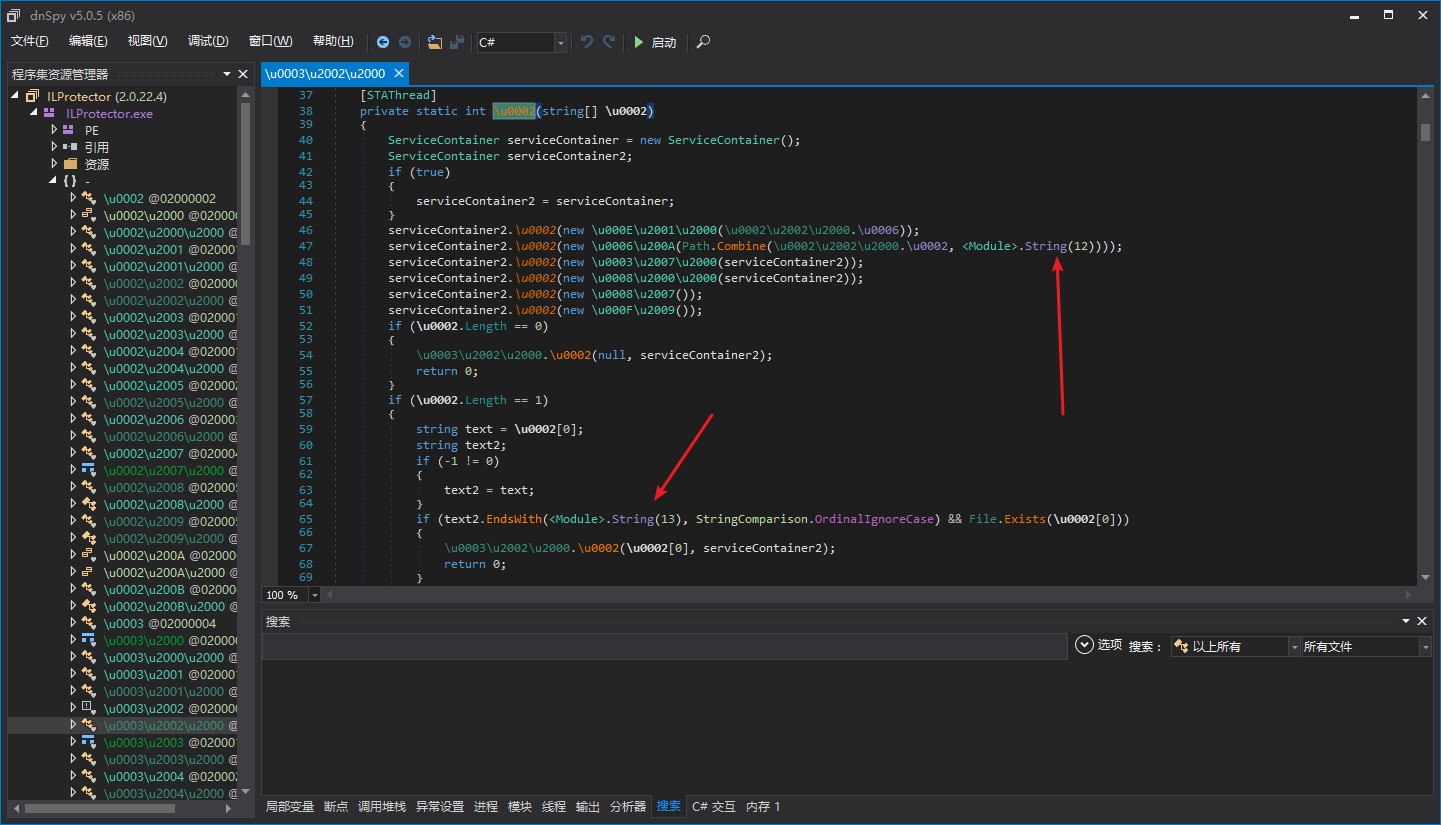
可是我们可以发现,好像还有字符串没有解密。我们再联系一下这个<Module>中的”internal static s String”,可以知道,这个和Invoke是一样的——一样的调用方式,就可以解密出字符串,这里就不继续贴代码了,因为真的是一样的,而且这个没有检测,直接调用就行。
解密出字符串的效果:
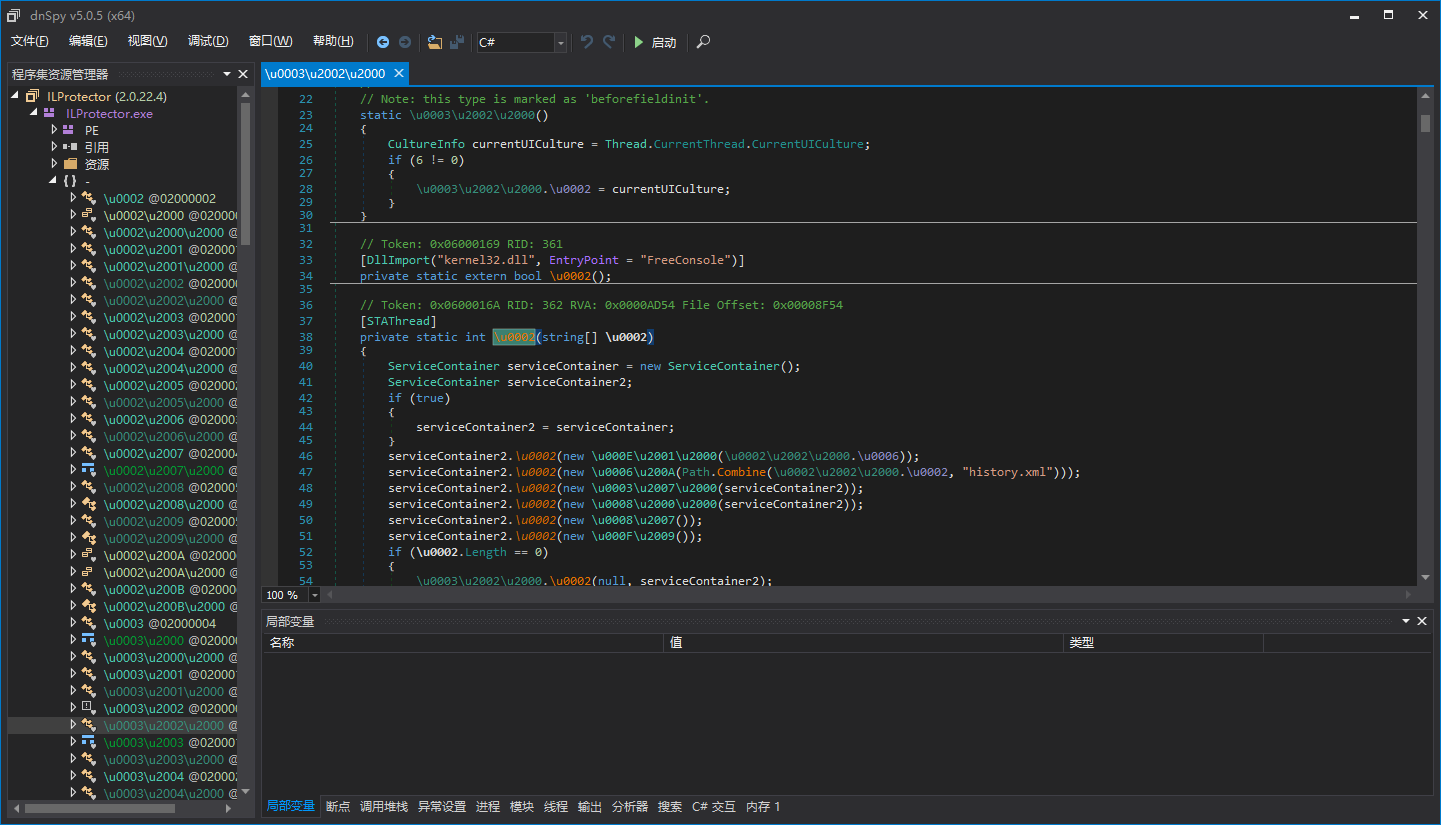
接下来,我们要移除ILProtector运行时的初始化代码。虽然不移除也没关系,但是为了完美,我们再完善一下脱壳机:
1 | private static void RemoveRuntimeInitializer() { |
代码中startIndex表示运行时初始化代码的开头,endIndex表示运行时初始化代码的结尾的后一句代码。因为方法体中可能存在跳转,又因为dnlib的一些特性,我们不能直接把Instruction换成Nop,而要这样:
1 | instructionList[i].OpCode = OpCodes.Nop; |
除此之外,被保护的程序集中还有一些别的ILProtector造成的残留代码,移除方法就不一一阐述。
放出成品脱壳机没有太大的意思,还是更希望读者能自己照着文章研究出脱壳机。而不是只会使用别人写好的,哪天加壳工具一更新,脱壳机失效,就不会脱壳了。
详解ILProtector并写出脱壳机
https://wwh1004.com/inside-ilprotector-and-writing-an-unpacker/